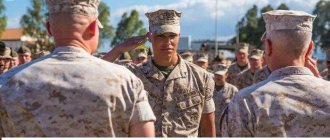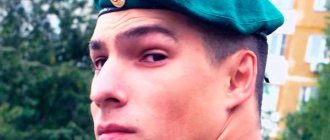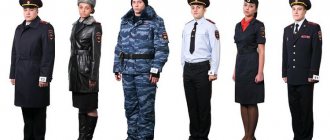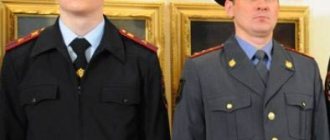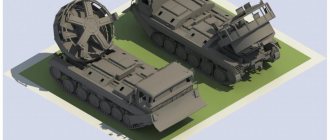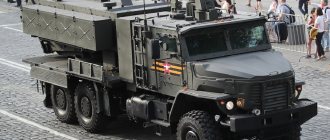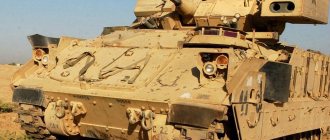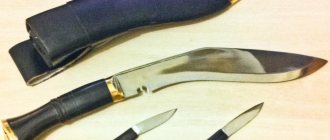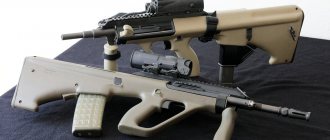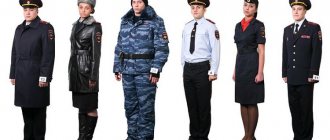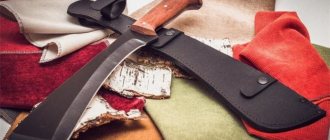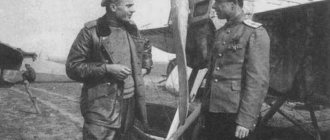Uniform for the season
The American uniform is not classified according to seasonality. The type of winter clothing implies the issuance of an additional insulated jacket or pea coat. In cold weather, employees can put on a variety of warm clothes, wear insulated jackets, coats and raincoats, the list of which is approved by the commander for the “winter clothing” uniform. Soldiers are issued a daily uniform for service, but with permission to purchase the uniform themselves.
The army has a requirement to wear a uniform for social events. The type of costume is indicated in the invitation.
All types of military uniforms are divided into:
- standard, green or olive;
- camouflage;
- three- and six-color, desert;
- white and snow white.
Shoes are worn black - for uniform, white - in accordance with the specified clothing model, suede (brown or beige) - with a camouflage suit.
Comparison of equipment of Russian and American soldiers
Reasons for the differences between American and Russian equipment:
- geographical position;
- technological progress;
- military experience;
- availability of resources.
We will not compare all the uniforms of an ordinary soldier, but only the main parameters.
Focus on climatic conditions
US equipment is primarily aimed at dry and hot terrain, while the Russian military has to adapt to local cold and rain.
Price
The second distinguishing criterion is price. To assemble one “warrior”, you need from $45,000. To build something like this for an American, you need $80,000.
Unloading system
In Russia, the military unloading vest BSh112 is used, which is not compact. The United States abandoned unloading vests in favor of the Molle innovation, which is located on American body armor. However, sometimes MOLLE II US ARMY backpacks with a built-in plastic frame are used.
Optional equipment
In this regard, Russia seriously lags behind a country where innovation is constantly taking place. The US soldier receives tactical gloves, a personal water backpack and special ballistic goggles with removable lenses.
Weight
Russians have to travel longer distances than Americans. Therefore, Russian components are 400-700 grams less than American ones.
US Army Uniforms
There are four subtypes of kits used:
- ceremonial day off;
- everyday;
- worker;
- field.
The cut style of different ranks is the same, the only difference is in the quality of the material and the use of finishing elements. Blue material is used to sew festive uniforms. The set includes: a cap, a jacket with stripes on the forearms, trousers with stripes on the side seams, a light shirt, a tie and shoes.
There are distinguishing marks for ordinary employees, sewn along the shoulder, and across the shoulders for commanders. The headdresses of senior ranks are stitched with gold-plated threads. There is also a variety of colors for shoulder straps and edgings used in patches.
LiveInternetLiveInternet
In the US Army, all military clothing is divided into utilitarian, i.e. special uniforms (Utility and Organization Uniforms), service uniforms (Service Uniforms) and uniforms (Dress Uniforms). The first is intended to be worn in combat conditions and during the performance of specific duties (flight, crews of combat vehicles, hospital, kitchen, sports), the second during everyday activities, and the third is approximately what we call “ceremonial out of formation”, “ceremonial weekend” " Those. it is not intended to be worn while on duty and military personnel wear it in cases where it is necessary to be festively or formally dressed (at ceremonial meetings, holiday events, visiting, in church, at funerals, etc.).
At the same time, the blue army uniform, although it is classified by the rules as uniform, in some cases is also used as a service uniform.
The main guiding document on the rules for wearing military army uniforms, Army Regulation 670–1 (AR 670-1), Chapter 20, defines the cases when this uniform can be worn:
a. In the performance of official duties, according to the orders of the unit commander. (If we interpret point “a” freely, then in this case the blue uniform can be equated to our dress uniform for the formation).
b. While participating in public events of a general or official nature during off-duty hours.
c. In other appropriate cases outside of duty at the request of the military personnel.
This Guide relates the blue army uniform to civilian clothing as follows: “...corresponds to a tuxedo...”. Those. off duty, when participating in various types of civilian official or semi-official events, a military personnel must wear this uniform when it is considered indecent for civilians to appear in clothing other than a tuxedo.
If the blue uniform is worn on duty, it is worn with a regular black tie, and if it is used as a uniform, then a black bow tie is worn.
Concluding the general overview, it should be noted that for generals, officers and warrant officers, blue army uniforms are included in the set of compulsory military clothing, i.e. a serviceman is obliged to have it and the commander has the right to order to wear it in a particular case. Soldiers and sergeants purchase it at their own request, i.e. paragraph "a" does not apply to them, with the exception of those soldiers and sergeants who serve in units such as honor guards, ceremonial companies, etc., where the blue uniform is necessary to perform specific duties associated with certain military rituals.
The author believes that the blue color of this dress uniform was predetermined by the long-standing traditions of the US Army. Even during the American Civil War of 1861-65. Federal soldiers wore blue uniforms. those. If for the Russian Army the traditional color of infantry uniforms is green, for Germany and Austria it is white, then for America it is blue. The armies of the world dressed in khaki at the beginning of the 20th century, and before that the color of the uniform was rather determined by the traditions of a particular army.
The blue army uniform is completely identical in cut to the green service uniform, but is sewn from blue fabric.
Single-breasted jacket made of wool gabardine, baratea, or wool blend fabrics such as twill, elastic.
Straight-cut trousers made of the same fabric.
The color of the generals' jacket and trousers is the same, but for all other officers, soldiers and sergeants, the trousers are made from the same material as the jacket, but the trousers are lighter.
Pictured left: Blue uniform with Warrant Officer rank insignia. Wearing a bow tie, i.e. for off-duty occasions.
Generals, officers and warrant officers wear special transverse shoulder straps on their shoulders, called “shoulder straps” in English, with rank insignia. Such shoulder straps are not worn on any other uniform. This type of shoulder straps has been preserved in the US Army since the 19th century.
For more information about these shoulder straps and rank insignia on such shoulder straps, see the article “Rank insignia of officers. Part 2" .
Generals wear ribbons of gold braid 3.81 cm wide on both sleeves at a distance of 7.62 cm from the bottom of the sleeve. The tape is positioned horizontally and wraps around the sleeve (1).
Officers (2) and warrant officers (3) at the same distance wear two braided ribbons with a width of 4.23 mm. separated by a colored ribbon of the same width. The color of the ribbon is determined by the first color of the officer's branch of service. For more information about the colors of the military branches, see the article “Insignia of officer ranks. Part 2" . Let us only note that all warrant officers of all branches of the military have a brown colored ribbon, i.e. in this case it does not indicate the branch of the military, but their belonging to the corps of warrant officers.
On their trousers, generals (4) wear stripes made of two gold ribbons 1.27 cm wide. with a gap between them also 1.27 cm. All other military personnel have one gold stripe 2.54 cm wide. (5).
The placement of awards, badges, emblems of military branches, name plates, and US military orders is similar to their placement on the green service uniform and is described in detail in the relevant articles on the site. It should be noted that on blue army uniforms, during off-duty periods, either award stripes or the awards themselves, full-size or in a miniature version, can be worn. While on duty, only award bars are worn on this uniform. Badges are worn in full-size or miniature form, but when wearing awards, the size of the badges must correspond to the awards (for full-size awards, only full-size badges, for miniature awards...).
In the picture on the left: blue army uniforms of soldiers and sergeants. The tie is worn for the service uniform option.
Features of the blue army uniform of soldiers and sergeants are as follows:
On their shoulders, soldiers and sergeants wear shoulder straps (shoulder loops) made of the same material as their jacket. The shoulder straps are edged with gold cord 3.2 mm wide. The width of the shoulder strap at the lower end is 6.35cm, at the upper end 3.81cm. The length of the shoulder strap is determined by the width of the soldier’s shoulders and it should not reach slightly to the edge of the collar. No insignia or badges are worn on shoulder straps.
The rank insignia of soldiers and sergeants is worn on both sleeves above the elbow. The color of the valves of the insignia is the same as the color of the jacket; the chevrons and arcs are gold. For more information about the insignia of ranks of soldiers and sergeants, see the corresponding articles on the site.
At the bottom of both sleeves, soldiers and sergeants wear a distance of 7.62cm. from the bottom of the sleeve there is a gold lace 3.2 mm wide. and above it are inclined galloon strips 4.23 mm wide. These bands wrap around the sleeve. One ribbon indicates 3 years of service.
Branch insignia and US collar badges are worn similarly to those on the green service uniform (see related articles on the website). The placement of badges and awards is similar to that of officers.
A blue cap is used as a headdress.
The photo on the right shows the blue army cap of a junior officer (the band is not wearing a ribbon according to the officer's branch of service).
The caps of generals (1) of all branches of the military have a dark blue ribbon on the band with oak leaves embroidered on it in gold. The same leaves are embroidered on the visor covered with black fabric.
The caps of senior officers (2,3) on the visor, also trimmed with black fabric, have the same oak leaves. The band is covered with a colored ribbon according to the officer’s first branch of service. Along the bottom of the band and along its top, a gold galloon ribbon 1.27 cm wide is applied to a colored ribbon. If the officer's branch of service has two colors, then a 3.2 mm wide cord is laid in the middle of each braided ribbon. the second color of the military branch.
The same caps as senior officers are worn by junior officers (4, 5) and warrant officers (6), but the visor is plain black leather.
The cap of soldiers and sergeants has a black leather visor and a black (instead of the gold officer's) leather chin strap. The band is covered with a ribbon of the same color as the color of the jacket (i.e. blue), and in the upper part of the band a gold galloon ribbon 1.27 cm wide is put on it.
The picture shows on the left (1) the cap of soldiers and sergeants of all branches of the military, on the right the cap of a junior officer (2) of the engineering troops. Part of the chin strap is not shown to allow the bottom edge of the band to be visible. The ribbon is scarlet (the first color of the engineering troops), and a white cord (the second color of the engineering troops) runs along the gold ribbons at the top and bottom of the band. It should be noted that the warrant officer's cockade has a different appearance than the officer's cockade and the color of the ribbon of warrant officers of all branches of the military is brown.
On blue uniforms, military personnel can wear (as appropriate) service, decorative and award aiguillettes.
The picture on the left shows the placement of aiguillettes.
An additional element of the blue army uniform is white knitted gloves, which the soldier puts on at his own request when off duty, or on duty by order of the commander.
In the US Army there is no division of uniforms into summer and winter. For all types of service uniforms and uniforms, there are additional items of clothing that allow you to protect yourself from the cold.
First of all, this is an all-weather black coat (Coat black, all weather), which is worn with a blue cap, a black scarf and black leather gloves. In very cold weather it can be worn with an insulating lining and a cold weather hat (Cap, cold weather, AG shade 489). All military personnel attach rank insignia to the corners of their coat collar. Signs can only be metal.
Generals, officers and warrant officers, in addition to the black all-weather coat, may also wear a blue cape, which can be paired with black leather gloves, a blue cap or a cold weather cap. The shade and material of the cape may differ from the material and shade of the jacket and trousers. The cape is fastened at the top with a gold chain. The color of the cape's lining is determined by the service member's first branch of service color. Rank insignia is not worn on the cape.
However, any insulating item (cold weather hat, black gloves, all-weather black coat, black scarf, blue cape) does not belong to the blue army uniform and is intended only for traveling to or from the event venue.
Only black Oxford style low boots and black socks may be worn with the blue army uniform.
Sources.
1.Army Regulation 670–1 (AR 670-1). Uniforms and Insignia. Wear and Appearance of Army Uniforms and Insignia. Headquarters Department of the Army, Washington, DC, 1 September 1992. Change 06-14-99.Chapter 19 2..Army Regulation 670–1 (AR 670-1). Uniforms and Insignia. Wear and Appearance of Army Uniforms and Insignia. Headquarters Department of the Army, Washington, DC, 1 July 2002.Chapter 20. 2. Website “Tagd On Line. The Adjutant General Directorate" (www-persom.army.mil/tagd)
US Marine Corps Uniform
The American soldier's uniform for the Marine Corps stands out for its diversity. The tailoring style and color scheme of the uniform are the most recognizable; the clothes are sewn according to military traditions. There are three subspecies:
- ceremonial weekend;
- everyday, work;
- field
The material for sewing the festive costume for employees contains the colors of the American flag. For everyday service, blue uniform colors are used. The dress uniform is white, intended for celebrations and social receptions. Commanding officers may wear a dagger to receptions.
The service uniform is made of green material. At this time, the form changes to utilitarian, but is not used on special occasions.
The color of the material for sewing field uniforms is camouflage: for service in forest areas - green/brown/black, for service in desert areas - sand/brown/gray. The set includes a brown leather belt, a light green T-shirt, light brown suede boots, an eight-cornered cap or a Panama hat. The Corps emblem is embroidered on the front of the cap or panama hat.
In hot weather, it is allowed to roll up the sleeves to the outside, with the wrong side up. In other troops, the sleeves are rolled up with the camouflage side on the outside with a cuff formed along the edge of the rolled up sleeve.
Combat and Special Skill Icons and Tabs[edit]
Source: [4]
Group 1[edit]
- Combat Infantry Badges
- Combat medical badges
- Combat Icons
Group 2[edit]
- Experienced Infantryman Badge
- Specialist field doctor badge
- Expert Soldier Badge
Group 3[edit]
- Army Aviator Badges
- Army Flight Surgeon Badges
- Army Aviation Badges
- Army Astronaut Badges (any Army Aviator, Flight Surgeon, or Aviation Badge with the Astronaut Device)
- Explosive Ordnance Disposal Icons
- Parachutist Badge
Group 4[edit]
- Parachutist Badges
- Pathfinder Sign
- Air attack icon
- Free fall parachutist military badges
- Space icons
- Diver badges
- Special Operations Diver Badges
- Special forces tab
- Ranger Tab
- Minesweeper tab
Group 5[edit]
- Driver and mechanic badges
Marksmanship badges
Main article: Marksmanship badges (USA)
- President's Hundred Tab
- International marksman insignia
- Rifleman insignia
- Interservice Competition Badges
- Competition insignia
- Qualifying marksmanship badges
US Navy uniform
The American military uniform of the Navy consists of a set made of blue material, without division by rank. It is considered everyday. For special occasions, the high command puts on a tailcoat and trousers, a vest, a cap, black boots, a bow tie, and a light shirt.
Each employee is issued two sets of uniforms. One set of clothes is sewn from thick woolen fabric. This is a winter uniform for employees. Another set made of thin fabric is designed to be worn in the warm season. For command personnel, the dress uniform is completely white. For employees in hot areas, the shirt has short sleeves.
For the cold season, a warm blue flannel shirt is provided. The working sailor uniform consists of a khaki set. The cap, socks, boots and belt are black. Naval aviation personnel in the Navy wear black boots, socks, green trousers and a service jacket. Shirt - blue or light green.
For working moments on a ship or boat, the technical team wears blue overalls. In cold or rainy times, a blue raincoat, a jacket for command personnel and an insulated jacket for sailors are provided. The command staff's buttons are yellow, the sailor's buttons are white.
Uniforms for the US Air Force
The American uniform for Air Force personnel was tailored to meet the needs of certain conditions. The material must not get wet, not be blown out in strong winds, have properties that allow it to withstand flames, and be comfortable in a working environment.
The clothing set of an American technical soldier includes a camouflage insulated jacket, overalls, leather boots or high boots. The camouflage uniform has blue, gray, and blue colors. Today, a new camouflage is being developed, which will soon replace the old one. The material is camouflage, painted green, gray, white, brown or sand.
Coast Guard Uniform
The US Army Coast Guard uniforms are varied. Suits and overalls are blue, shoes are black; for everyday service, for work, there are suits in khaki, black/olive/brown, usually with brown or sand suede boots. The ceremonial uniform of the coast service is made of white fabric. A white cap and boots are appropriate here.
For women serving in the coast guard, they are issued a set of clothing, which includes a blue skirt or trousers, a blue shirt, a jacket, and shoes.
Identification badges[edit]
Main article: United States Uniform Services identification badges
- Army Staff Identification Badge
- Guard of the Tomb of the Unknown Soldier, identification mark
- Military horseman's identification badge
- Master Gunner Identification Badge
- Drill Sergeant Identification Badge
- Instructor Identification Badges
- Army Recruiter Badges
- Career Advisor Badge
- Military Police Identification Badge
- Criminal Investigation Division Special Agent Badge
- Counterintelligence Special Agent Badge
- Combat service badges
US Army patches and insignia
Various distinctive stripes indicate:
- structural unit of the unit;
- type of army;
- experience;
- official position and awards.
Badges, ribbons and medals are also worn. A cap or cap is worn as directed by the unit commander, but in transport, in a car, a serviceman is required to wear a cap. For violating the rules established for wearing clothing, the punishment is three months' imprisonment in a unit prison, without payment of wages.
